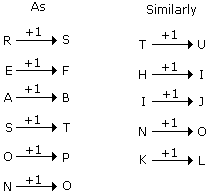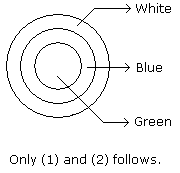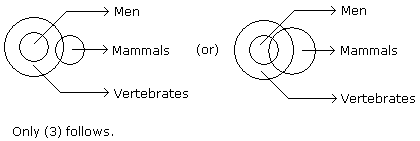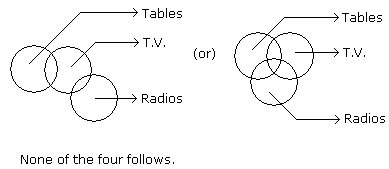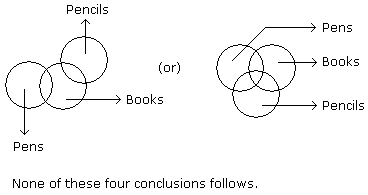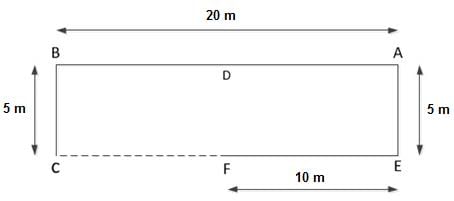Syndicate Bank PO Mock Test - 5 - Banking Exams MCQ
30 Questions MCQ Test - Syndicate Bank PO Mock Test - 5
40 persons are sitting in a row. How many persons are sitting between 31st person from left and 25th person from right?
In a row of 40 girls, when Komal was shifted to her left by 4 places her number from the left end of the row become 10. What was the number of Swati from the right end of the row, if Swati was three places to the right of Komal’s original position?
Directions to Solve
In each of the following questions find out the alternative which will replace the question mark.
Question -
Peacock : India :: Bear : ?
Directions to Solve
In each of the following questions find out the alternative which will replace the question mark.
Question -
REASON : SFBTPO :: THINK : ?
Directions to Solve: In each of the questions below consists of a question and two statements numbered I and II given below it. You have to decide whether the data provided in the statements are sufficient to answer the question. Read both the statements and
Give answer:
- (A) If the data in statement I alone are sufficient to answer the question, while the data in statement II alone are not sufficient to answer the question
- (B) If the data in statement II alone are sufficient to answer the question, while the data in statement I alone are not sufficient to answer the question
- (C) If the data either in statement I alone or in statement II alone are sufficient to answer the question
- (D) If the data given in both statements I and II together are not sufficient to answer the question and
- (E) If the data in both statements I and II together are necessary to answer the question.
Question: Among T, V, B, E and C, who is the third from the top when arranged in the descending order of their weights ?
Statements:
I.B is heavier than T and C and is less heavier than V who is not the heaviest.
II.C is heavier than only T.
Directions to Solve: In each of the questions below consists of a question and two statements numbered I and II given below it. You have to decide whether the data provided in the statements are sufficient to answer the question. Read both the statements and
Give answer:
- (A) If the data in statement I alone are sufficient to answer the question, while the data in statement II alone are not sufficient to answer the question
- (B) If the data in statement II alone are sufficient to answer the question, while the data in statement I alone are not sufficient to answer the question
- (C) If the data either in statement I alone or in statement II alone are sufficient to answer the question
- (D) If the data given in both statements I and II together are not sufficient to answer the question and
- (E) If the data in both statements I and II together are necessary to answer the question.
Question: Which word in the code language means 'flower' ?
Statements:
I.'de fu la pane' means 'rose flower is beautiful' and 'la quiz' means 'beautiful tree'.
II.'de la chin' means 'red rose flower' and 'pa chin' means 'red tea'.
Directions to Solve: In each of the questions below consists of a question and two statements numbered I and II given below it. You have to decide whether the data provided in the statements are sufficient to answer the question. Read both the statements and
Give answer:
- (A) If the data in statement I alone are sufficient to answer the question, while the data in statement II alone are not sufficient to answer the question
- (B) If the data in statement II alone are sufficient to answer the question, while the data in statement I alone are not sufficient to answer the question
- (C) If the data either in statement I alone or in statement II alone are sufficient to answer the question
- (D) If the data given in both statements I and II together are not sufficient to answer the question and
- (E) If the data in both statements I and II together are necessary to answer the question.
Question: How many students in a class play football ?
Statements:
I.Only boys play football.
II.There are forty boys and thirty girls in the class.
Directions to Solve: In each of the questions below consists of a question and two statements numbered I and II given below it. You have to decide whether the data provided in the statements are sufficient to answer the question. Read both the statements and
Give answer:
- (A) If the data in statement I alone are sufficient to answer the question, while the data in statement II alone are not sufficient to answer the question
- (B) If the data in statement II alone are sufficient to answer the question, while the data in statement I alone are not sufficient to answer the question
- (C) If the data either in statement I alone or in statement II alone are sufficient to answer the question
- (D) If the data given in both statements I and II together are not sufficient to answer the question and
- (E) If the data in both statements I and II together are necessary to answer the question.
Question: On a T.V. channel, four serials A, B, C, and D were screened, one on eacn days, on four consecutive days but not necessarily in that order. On which day was serial C screened?
Statements:
I. The first serial was screened on 23rd, Tuesday and was followed by serial D.
II. Serial A was not screened on 25th and one serial was screened between serials A and B.
Directions to Solve
In each of the following questions two statements are given. Which are followed by four conclusions (1), (2), (3) and (4). Choose the conclusions which logically follow from the given statements.
Question -
Statements: All green are blue. All blue are white.
Conclusions:
- Some blue are green.
- Some white are green.
- Some green are not white.
- All white are blue.
Directions to Solve
In each of the following questions two statements are given. Which are followed by four conclusions (1), (2), (3) and (4). Choose the conclusions which logically follow from the given statements.
Question -
Statements: All men are vertebrates. Some mammals are vertebrates.
Conclusions:
- All men are mammals.
- All mammals are men.
- Some vertebrates are mammals.
- All vertebrates are men.
Directions to Solve
In each of the following questions two statements are given. Which are followed by four conclusions (1), (2), (3) and (4). Choose the conclusions which logically follow from the given statements.
Question -
Statements: All the phones are scales. All the scales are calculators.
Conclusions:
- All the calculators are scales.
- All the phones are calculators
- All the scales are phones.
- Some calculators are phones.
Directions to Solve
In each of the following questions two statements are given. Which are followed by four conclusions (1), (2), (3) and (4). Choose the conclusions which logically follow from the given statements.
Question -
Statements: Some tables are T.V. Some T.V. are radios.
Conclusions:
- Some tables are radios.
- Some radios are tables.
- All the radios are T.V.
- All the T.V. are tables.
Directions to Solve
In each of the following questions two statements are given. Which are followed by four conclusions (1), (2), (3) and (4). Choose the conclusions which logically follow from the given statements.
Question -
Statements: Some pens are books. Some books are pencils.
Conclusions:
- Some pens are pencils.
- Some pencils are pens.
- All pencils are pens.
- All books are pens.
If M x N means M is the daughter of N; M + N means M is the father of N; M % N means M is the mother of N and M - N means M is the brother of N then P % Q + R - T x K indicates which relation of P to K?
If P + Q means P is the brother of Q; P x Q means P is the father of Q and P - Q means P is the sister of Q, which of the following relations shows that I is the niece of K?
Pointing towards a girl, Abhisek says, "This girl is the daughter of only a child of my father." What is the relation of Abhisek's wife to that girl?
If A $ B means B is the father of A; A # B means B is the mother of A; A * B means B is the sister of A and A @ B means B is the husband of A, which of the following indicates that N is the grandmother of P?
Anupam said to a lady sitting in a car, "The only daughter of the brother of my wife is the sister-in-law of the brother of your sister." How the husband of the lady is related to Anupam?
Direction(11-15): Study the following information to answer the given questions
A$B means A is not smaller than B A@B means A is neither smaller than nor equal to B A#B means A is neither greater than nor equal to B A&B means A is neither greater than nor smaller than B A*B means A is not greater than B
Statements:
O & A, A $ R, R # S, S * Q
Conclusions:
I. Q @ R II. S @ O
III. R & O IV. R # O
A$B means A is not smaller than B A@B means A is neither smaller than nor equal to B A#B means A is neither greater than nor equal to B A&B means A is neither greater than nor smaller than B A*B means A is not greater than B
Q. Statements:
A * E, E $ F, F # O, O
@ L
Conclusions:
I. L # F
II. E @ O
III. A # O
IV. E @ L
A$B means A is not smaller than B A@B means A is neither smaller than nor equal to B A#B means A is neither greater than nor equal to B A&B means A is neither greater than nor smaller than B A*B means A is not greater than B
Q. Statements:
B @ Q, Q # A, A & L,
L * N
Conclusions:
I. N $ A
II. L @ Q
III. B @ N
IV. Q # N
A$B means A is not smaller than B A@B means A is neither smaller than nor equal to B A#B means A is neither greater than nor equal to B A&B means A is neither greater than nor smaller than B A*B means A is not greater than B
Q. Statements:
A $ E, E @ F, F * G,
G # H
Conclusions:
I. H @ E
II. A $ G
III. E @ H
IV. A @ F
Directions: This question given below is followed by two arguments numbered I and II. You have to decide which of the following arguments is a ‘strong’ argument and which is a ‘weak’ argument.
Statement:
Should corporal punishment be banned in schools?
Arguments:
I. No. Teachers as responsible adults can be trusted with using the punishment only as a last resort, and on a case-to-case basis.
II. Yes. Hitting a student is only an easy way out to create an image of trying to change the student, whereas there are better options available for fundamentally changing the behaviour of the student.
Directions: This question given below is followed by two arguments numbered I and II. You have to decide which of the following arguments is a ‘strong’ argument and which is a ‘weak’ argument.
Statement:
Should Census be done more often?
Arguments:
I. Yes. Lot of people migrate from one place to another quite frequently and the census results might be obsolete within a year.
II. No. There are huge costs associated with carrying out the census and increasing its frequency might put unnecessary burden on the exchequer.
Directions: This question given below is followed by two arguments numbered I and II. You have to decide which of the following arguments is a ‘strong’ argument and which is a ‘weak’ argument.
Statement:
Should the Government introduce Gross Happiness Index on the lines of that introduced in Bhutan?
Arguments:
I. Yes. It will greatly help India in becoming a prosperous nation.
II. No. Bhutan has not gone anywhere even after introducing GHI over four decades ago.
Directions: This question given below is followed by two arguments numbered I and II. You have to decide which of the following arguments is a ‘strong’ argument and which is a ‘weak’ argument.
Statement:
Should there be restrictions on free media?
Arguments:
I. Yes. Sometimes restrictions are needed to control free media.
II. No. It’s the fourth pillar of our democracy.
Directions: This question given below is followed by two arguments numbered I and II. You have to decide which of the following arguments is a ‘strong’ argument and which is a ‘weak’ argument.
Statement:
Should young people move away from home when they’ve crossed the age of 18?
Arguments:
I. Yes. It greatly helps them in standing on their own feet and becoming independent.
II. No. Their parents need their support.
In the question symbols $, #, % are used for different meanings as follows.
$ means ‘neither greater nor equal to’.
# means ‘neither greater nor smaller than’.
% means ‘neither smaller nor equal to’.
In each of the following questions, assuming the given statements to be true, find out which of the two conclusions I and II given below them is/are definitely true.
Statements: T % I, I # L, L % U
Conclusions: I. T $ L
II. U $ T
Suraj started from point X and walked 5 km towards west. He then turned left and walked 2 km, after which he turned left again and walked 7 km.
In which direction was he in the end with respect to point X?
Point A is 20 m to the east of point B. Point B is 5 m to the north of point C. Point D is 10 m to the east of point B. Point E is 5 m to the south of point A. Point F is 10 m to the west of point E.
Which of the following points lie in a straight line?




